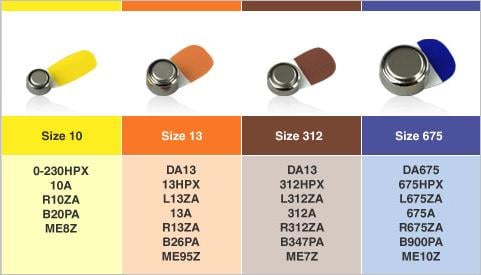Hearing Aid Battery Guide
How is the running time and performance of Mercury Free batteries different from Standard batteries?
Mercury Free and Standard batteries’ running time is equal when used within the same category of hearing instruments. Non-mercury containing batteries are also more environmentally friendly because of the absence of mercury to the cell.
The Mercury Free cells are developed for new requirements of hearing aids with wireless functionality.
Note: Battery life in general is shorter for hearing aid with wireless functions than it would be with a non-wireless hearing instruments. This depends on battery composition (Mercury Free or Standard Zinc Air)
What is the purpose of the tab in Zinc Air hearing aid batteries?
The tab seals the air holes on the battery since Zinc Air hearing aid batteries use air as its source of energy. Once the tab is removed, it would usually take about two minutes before the hearing aid is activated/charged. That is the time the battery compartment can be closed. When not closed, in worst cases, the battery can be damaged and will not come back to normal Voltage level needed.
Remember never to remove the tab when the battery is not to be used. Reattaching the tab will not prolong the life of the battery.
How do I know the various sizes of hearing aid batteries?
Hearing aid batteries come in different standard sizes and are color-coded 10, 13, 312, 675 and 675P Implant.

|
Size |
Typical Capacity (mAh) |
Voltage (V) |
Chemical System |
Diameter (mm) |
Height (mm) |
Weight (g) |
|
Size 10 |
100 |
1.45 |
Zinc Air |
5.8 |
3.6 |
0.3 |
|
Size 13 |
300 |
1.45 |
Zinc Air |
7.9 |
5.4 |
0.83 |
|
Size 312 |
170 |
1.45 |
Zinc Air |
7.9 |
3.6 |
0.58 |
|
Size 675 |
650 |
1.45 |
Zinc Air |
11.6 |
5.4 |
1.83 |
|
Size 675P Implant |
540 |
1.4 |
Zinc Air |
11.6 |
5.4 |
1.85 |
How to efficiently use my Hearing Aid Device?
1. Open the battery door (battery compartment) at night. When not using your hearing aid, opening the battery door will minimize battery drain.
2. Always keep your devices clean and dry.
3. Clean your hearing aid every day following the manufacturer’s cleaning instructions.
4. Be aware of features that your hearing aid uses that may drain batteries faster such as:
a. Feedback Cancelling
b. Noise Reduction
c. Streaming mode (streaming audio from TV or other wireless source)
How can I get the best performance my hearing aid battery can give?
To get the best performance of your hearing aid battery and to reduce from being drained, turn off your hearing aid when not in use and put it somewhere safe and dry (never leave it on the bathroom counter while you shower), and leave the battery compartment open, this way it also helps to keep the battery from corroding which is not good for your hearing aid. Only buy enough batteries to last you 6 – 12 months to make sure batteries maintain peak capacity for when you need them.
How To Change Your Hearing Aid Battery
1. Remove the drained battery from your device.
2. Spin the lock dial on the back of the package to securely position a battery with the forward facing door.
3. Open the door and remove the Rayovac hearing aid battery from the package.
4. Re-close the door to ensure batteries stay clean, secured and protected.
5. Remove the tab and let sit for one minute to allow air to activate the battery.
6. Then insert the battery into your device with the flat side facing up and close the door.
7. Your hearing aid should now be powering up and is ready for use.
How to properly dispose a used hearing aid battery?
Zinc Air hearing aid batteries are classified as non-hazardous waste, while “mercury-free” can be dispose in household waste, it is strongly recommended that you follow local state guidelines on how to safety dispose your hearing aid batteries.
How long is the average running time of a hearing aid battery?
The running time of the hearing aid battery varies on the hours of use per day, the amplification and the type of the hearing aid being used. Factors like streaming has a direct impact on the running time being consumed of a battery due to the high currents it draws, and depending on how often and how long streaming is active over the day.
What causes a hearing aid not to work despite having a new battery?
There are several possible reasons and some things to check:
1. The battery has not enough time to be charged after being removed from the plastic tab.
2. Damaged/deformed battery surface can cause poor contact with battery terminal of the hearing aid.
3. In some rare cases, the battery has no power even if it is brand new or when not activated correctly. Also check if there’s a built up dirt on the battery terminal of the hearing aid causes poor contact.
4. The battery’s size does not fit into the hearing aid battery housing cavity.
What can I do to prevent my hearing aid battery to expand and leak?
Removing the batteries from the device when not in use help to avoid corrosion and damage from the trapped moisture. Make it a habit not to leave the battery in the hearing aid after end of life. Take note that extreme temperatures and high humidity levels can influence the battery chemistry and lead to swelling.
Best practices you can use to keep your hearing aid batteries well-maintained and help them last as long as possible.
1. Make it a habit to use your oldest package of hearing aid batteries first.
Even though hearing aid batteries can be stored for quite a while, the longer you keep them in storage, the shorter their life will be. And your spare batteries will never get old fast the more often you use the oldest package first.
2. Keep your extra hearing aid batteries in a dry, and room temperature place.
Extreme temperatures and high humidity levels can badly affect the life of your hearing aid batteries thus, never leave your hearing aid batteries in the refrigerator or bathroom.
3. Never remove the plastic tab from each pack’s battery until you’re ready to use it.
Take note that the plastic tab keeps the battery fresh while it’s in storage, and as soon as you peel it off, the battery is activated.
4. Wash your hands before replacing your hearing aid battery.
Grease and dirt from your hands can be transferred to the battery, which has a negative effect to the life span of the battery and to the hearing aid itself.
5. Leave the battery out for five full minutes after being removed from the plastic tab.
Recent research has shown that a battery’s life can be extended by as much as 2-3 days if you wait five whole minutes, after removing the tab and before inserting the battery. This is because when you take the plastic tab off, the zinc in the battery mixes with the air to power it up.
6. Leave the battery compartment open when you’re not using your hearing aids.
To allow excess moisture to escape and to reduce your battery being drained, turn off your hearing aid when not in use and put it somewhere safe and dry (never leave it on the bathroom counter while you shower!), and leave the battery door open, this way it also helps to keep the battery from corroding which is not good for your hearing aid.
7. Best to use a hearing aid dehumidifier.
Dry storage kits and hearing aid dehumidifiers provide a safe place to store your devices when not in use and protect both your hearing aid and its batteries.
8. Remove the batteries entirely if the device is not in use for an extended period of time.
Removing the batteries from the device when not in use help to avoid corrosion and damage from the trapped moisture.
ZINC AIR BATTERY CONSTRUCTION
HOW DOES A ZINC AIR - HEARING AID BATTERY WORK?
ACCESSORIES FOR HEARING AID BATTERIES
COCHLEAR IMPLANTS

